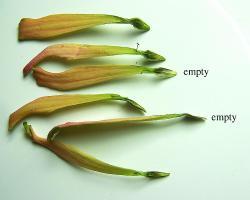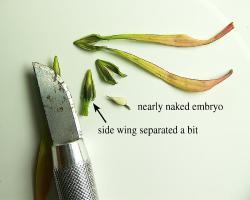carebear2056 said:My question to you now is about seed saving. Once I have pollinated a flower, I wait a few days before harvest, correct? Then, when I collect seeds, is there anything in particular that tells me a seed has been fertilized? I noticed some seeds are white while others are darker.
Hi Carebear,

Glad you are feeling better. From the time it is pollinated, it takes a zinnia embryo about three weeks to develop fully. At that time the seed will be plump and green and the petal can still have its normal coloration. You can either plant the green seed or dry it for storage and use at a later time. A good green seed will be plump with a fully developed embryo, while an "empty" green seed will be obviously flat and lightweight and can't germinate. Since zinnia petals appear sequentially over a period of weeks, you may be harvesting green seeds from a zinnia bloom over a period of several weeks. If you are persistent in pollinating a head, it can eventually produce 50 to 100 or more good green seeds.

The "skin" of a green seed is still alive and, for that reason, it is impervious to water. If you decide to plant the green seed immediately for quick turnaround to the next generation, it will be slow to germinate because it will take a week to 10 days for the live skin to die and become pervious to water. In order to speed up the germination, you can "breach" the seed coat in any of several ways, using a sharp knife like an X-Acto knife.

Sometimes I use a head-mounted magnifier to help in the close work of breaching green seeds. But the magnifier is optional. Notice the possibility of removing a naked embryo altogether. I have on occasion planted a whole flat of naked embryos. The embryos are ivory-white. They come up very quickly. If you have questions about any of this, don't hesitate to ask.
ZM


